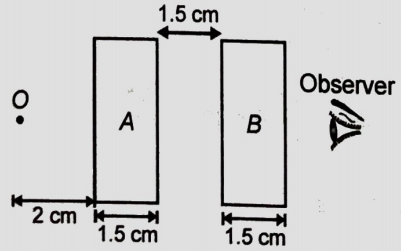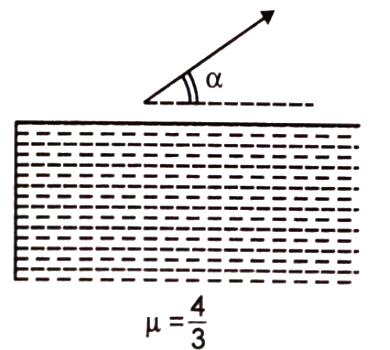An object O is placed on one side of two glass slabs A and B of thickness 1.5 cm and refractive index 1.5. The position of the image of O, when viewed from the other side of slab B, will be:

1. 1 cm away from slab A
2. 1.5 cm away from slab A
3. 2 cm away from slab A
4. 2.5 cm away from slab A

A virtual image of an object is formed by a concave lens. The lens is then coupled (kept in contact) with a convex lens. A virtual image is again formed. Then the image, now
1. Shifts away from lens system
2. Shifts towards lens system
3. Remains at its original position
4. Data are insufficient to predict whether it will shift towards or away from the lens system.
The correct statement is:
| 1. | The intermediate image in a compound microscope is real, erect and magnified |
| 2. | Intermediate image in a compound microscope is real, inverted, but diminished |
| 3. | Intermediate image in a compound microscope is virtual, erect and magnified |
| 4. | Intermediate image in a compound microscope is real, inverted and magnified |
A compound microscope has two convex has a system with focal lengths 2 cm and 5 cm. An object is 2.5 cm away from the objective lens. The tube length of the microscope when magnification is maximum is equal to
1. 18.2cm
2. 14.2 cm
3. 8.2 cm
4. 4.2 cm
A particle is thrown at an angle in the air as shown in the figure. The angle received from the inside water is.

1.
2.
3.
4.
A convex mirror of focal length f forms an image, which is times the length of the object. The distance of the object from the mirror is
1. (n - 1)f
2. f
3. f
4. (n + 1)f
We combined a convex lens of focal length with a concave lens of focal length and their combined focal length is F. The combination of these lenses will behave like a concave lens, if
1. >
2. <
3. =
4.
A ray of light is incident grazing on an equilateral prism of refractive Index = 2. The angle of emergence is
1.
2.
3.
4.
A ray of light is incident on an equilateral glass prism placed on a horizontal table as shown. For minimum deviation, a true statement is:

| 1. | \(PQ\) is horizontal |
| 2. | \(QR\) is horizontal |
| 3. | \(RS\) is horizontal |
| 4. | Either \(PQ\) or \(RS\) is horizontal |
Assertion (A): A convex lens made up of glass can never form a virtual, erect, and diminished image.
Reason (R): Convex lens can give only a virtual enlarged image when an object is placed between the focus and pole of the mirror.
(1) Both Assertion and Reason are true and the reason is the correct explanation of the assertion.
(2) Both Assertion and Reason are true but the reason is not the correct explanation of the assertion.
(3) Assertion is a true statement but Reason is false.
(4) Both Assertion and Reason are false statements.






